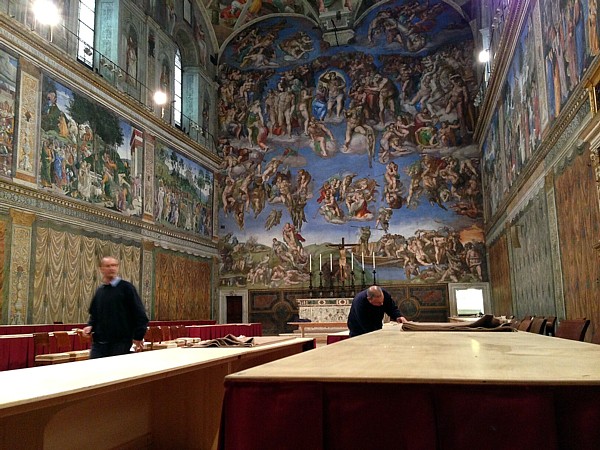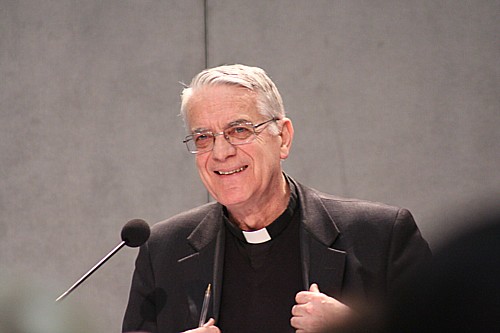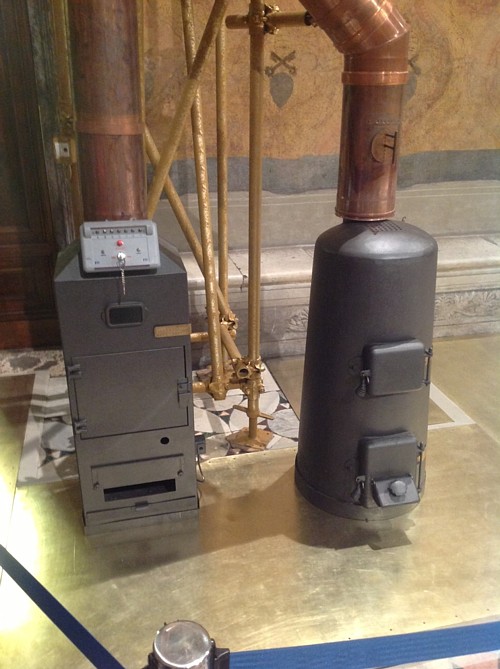Sistine Chapel Conclave Preparation Nears Completion
Vatican also gives details on the latest discussions and when to expect to see smoke.

Preparations to ready the Sistine Chapel are nearing completion in time for the conclave to begin on Tuesday.
Restorers, electricians, mechanics, carpenters, seamstresses, assemblers, electronic technicians and other labourers have been hard at work since Tuesday, fitting two stoves and a chimney to burn the ballots and reveal the election results (white smoke = pope elected; black smoke no result). Earlier today, firemen installed the chimney on the roof of the Sistine Chapel, from which the world will be able to see the smoke's color.
Carpenters have laid an elevated floor in the Chapel to create a uniform area to work and walk on, and to protect the original mosaic paving. Meanwhile, seamstresses have been sewing together lengths of cloth to create table covers.
Around the altar, 115 cherry wood chairs have been put in place, each engraved with the name of the cardinal who will occupy it, with 12 wooden tables covered in beige and bordeaux fabric where the cardinals will prepare their ballots. They will cast their votes in front of Michelangelo's fresco of “The Last Judgment” on the wall of the altar.

The Vatican says that after the chimney is installed, it will be submitted to a series of tests using chemicals to emit a yellow smoke so as not to confuse the increased number of passers-by in St. Peter's Square.
The chimney is just the last piece of the mechanism that will produce the smoke. The two iron stoves it is attached to were installed yesterday.
The first stove (on right in picture) was cast in 1938. It has the dates of the five conclaves it has been used in etched upon it—from the one electing Pius XII in 1939 until the latest, when Cardinal Ratzinger became Benedict XVI in 2005. This older oven is used to burn the balloting papers.
The modern one (pictured, on the left), is equipped with an electronic device and will add the chemicals to produce the black or white smoke indicating the result of the voting until the election occurs.
There are two voting sessions planned for each morning and each afternoon that the Conclave continues.
Besides the Cardinal electors, the only others who will be present in the Sistine Chapel are the Master of Papal Liturgical Celebrations and Cardinal Prospero Grech, O.S.A., who will preach the second meditation provided for in No. 13 of the Apostolic Constitution “Universi Dominici Gregis” to the Cardinal electors.
***
A summary from VIS on this morning’s Vatican briefing:
Vatican City, 9 March 2013 (VIS) – “The first order of business of the eighth General Congregation, which met yesterday evening and in which 145 cardinals participated, was to vote on the date to begin the Conclave. Cardinal Dean Angelo Sodano, expressing the wishes of all and after having consulted with the Cardinal Carmelengo Tarcisio Bertone, S.D.B., regarding the preparations at the Domus Sanctae Marthae, proposed the date of Tuesday, 12 March. The overwhelming majority immediately voted in agreement,” reported Fr. Federico Lombardi, director of the Holy See Press Office. “There was no difference of opinion between the cardinals and the percentage of votes in favour of to those against was around 10 to one. Moreover,” Fr. Lombardi added, “the full complement of Cardinal electors was already reached and it was no longer considered necessary to wait further, as they already had time to reflect on their decision.”
Fifteen cardinals intervened during the course of the Congregation and two newly arrived cardinals were sworn in, neither of which is a Cardinal elector: Cardinal Miguel Obando Bravo, S.D.B., archbishop emeritus of Managua, Nicaragua, and Cardinal Gaudencio Borbon Rosales, archbishop emeritus of Manila, Philippines.
During the ninth General Congregation that met this morning, the cardinals spoke about moving into the Domus Sanctae Marthae, which will be their residence for the duration of the Conclave. “It was agreed by majority that the move will take place on Tuesday morning, beginning from 7:00am, that is, the same day that the Conclave begins. (This is a change from an earlier announcement saying the cardinals would move in on the eve of the conclave).
A “Pro eligendo Romano Pontifice” Mass will be celebrated by the Cardinal Dean at 10:00am that morning in St. Peter's Square. Rooms were also assigned, by lot, Fr. Lombardi said.
“This morning 17 cardinals intervened, speaking on the same general themes that have been previously reported, including: expectations regarding the new Pope, activities of the Holy See and its Dicasteries, and improving the Curia. In total, there have been 133 interventions in the General Congregations and, keeping in mind those scheduled for Monday, that number will probably reach 150.”
At the end of the press conference, the schedule for the sessions of the Conclave was presented:
Tuesday 12 March:
* At 3:45pm, the cardinals will move from the Domus Sanctae Marthae to the Pauline Chapel in the Apostolic Palace.
* At 4:30pm, the cardinals will process from the Pauline Chapel to the Sistine Chapel and, after they have all taken the oath, the Master of Papal Liturgical Celebrations will give the order “Extra omnes” for all those not taking part in the Conclave to leave the Sistine Chapel. The cardinals will listen to a meditation given by Cardinal Grech, concerning the grave duty incumbent on them and thus on the need to act with right intention for the good of the Universal Church, after which they will proceed to the first vote.
* At 7:00pm they will pray Vespers and, at 7:30pm, will return to the Domus Sanctae Marthae.
Wednesday 13 March
* The cardinals will move from the Domus Sanctae Marthae to the Pauline Chapel at 7:45am where, at 8:15am, they will celebrate Mass.
* At 9:30am they will enter the Sistine Chapel, pray the Liturgy of the Hours, and proceed to the voting process.
* Around 12:00pm they will return to the Domus Sanctae Marthae and, after lunch there, will go back to the Sistine Chapel at 4:00pm where they will pray briefly and resume the voting procedure until 7:00pm.
***
This coming Monday, 11 March, all the auxiliary personnel needed to ensure the smooth operations of the Conclave will take the oath of secrecy and those images will be broadcast by Vatican Television.
Since there are two votes each morning and afternoon, Fr. Lombardi stated that the 'fumata' (smoke signalling the election or non-election of a pontiff) that is produced from the burning of the ballots from those two voting processes could be expected around 12:00pm, in the case of the morning, or 7:00pm, in the case of the evening, unless the first of the two votes produces an election. In such an instance, the “fumata” would obviously take place earlier - probably around 10.30am and 5.30pm, but these are only estimates. (Note that next week, because of DST changes in the U.S. but not in Italy this weekend, Rome time is 5 hours ahead of EST, not 6).

Fr. Lombardi reported that the commission that, under the direction of the Camerlengo, is responsible for sealing the entrances to the areas of the Conclave and carrying out the other operations necessary for the safeguarding of the Conclave was established. It is led by the Cardinal Camerlengo and among its members are the Substitute of the Secretariat of State, the Commandant of the Swiss Guards, members of the Gendarmerie, and notaries.
Finally he reported that the Pope's Fisherman's Ring—which exists in two forms, the ring itself and as a stamp used to seal documents—as well as two stamps—a larger and a smaller one—and the master lead seal of the pontificate were all destroyed, the images scratched out in the form of a cross to render them useless. The next Pope's ring will bear the same image of Peter casting his net but, naturally, will have the new pontiff's name inscribed above the image.
It was also communicated that tomorrow, Sunday, 10 March, various cardinals will celebrate Mass at their titular churches, inviting the faithful to pray for the Church and for the election of the new pontiff.














